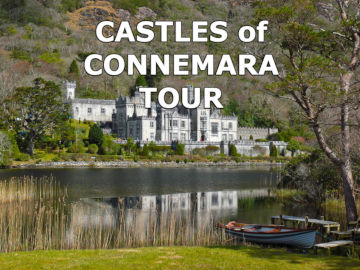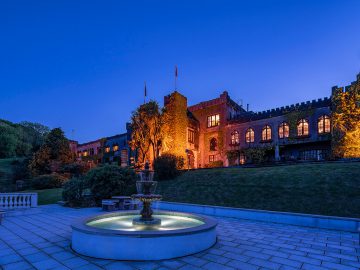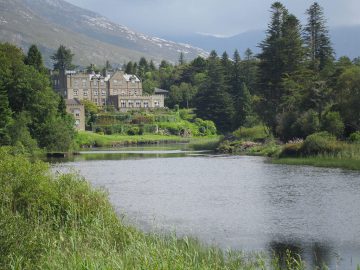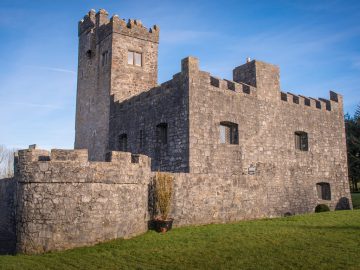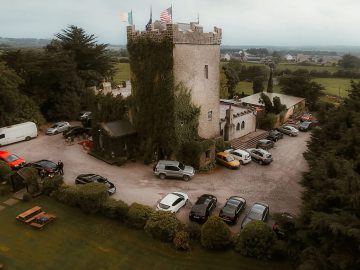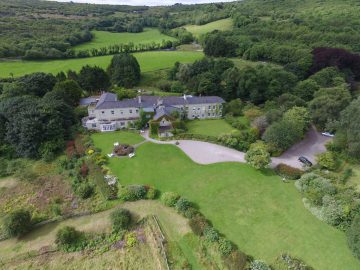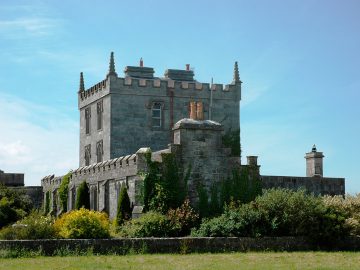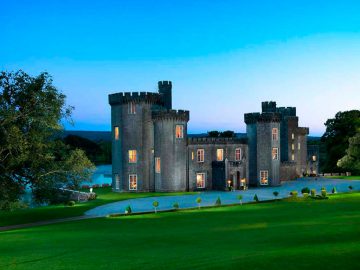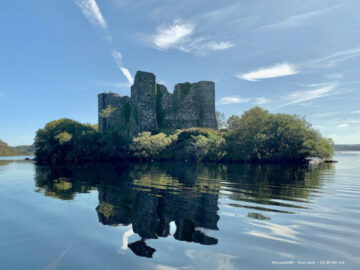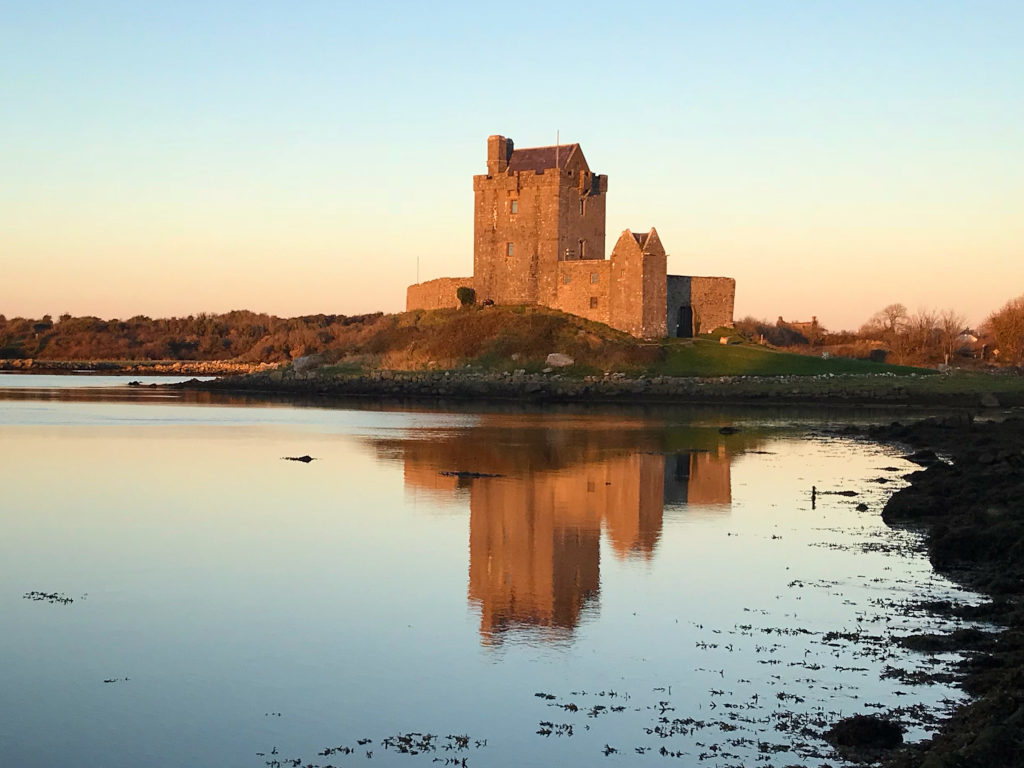
Best Castles to Explore
Top castles to visit in Galway
From it’s inception, Galway’s rich history has been dominated by the fourteen families known as the 14 tribes of Galway. Leading public figures invariably came from these families. The family names pervade the city in the names of buildings and are used for each of the many roundabouts visitors will pass when coming to Galway. The names were Athy, Blake, Bodkin, Browne, Darcy, Deane, French, Font, Joyce, Kirwan, Lynch, Martin, Morris and Skerrett families.
During the Middle Ages the city was a key trading port. The most common goods traded were wine, wools, skins, and leather. In the late middle ages, the English monarchy steadily ceded their power in rural Ireland, and eventually many castles and lands were one again held by local clans.
To this day county Galway is dotted with the remnants of countless ancient castles and old manor houses sprawled amid stunning landscapes. There are more than 200 castles spread out all over the county. Some lie in ruins, while others are partly or fully restored, all having compelling stories to tell and discover.
Aughnanure Castle
Aughnanure Castle, close to the picturesque banks of the Lough Corrib and about two miles from Oughterard, was occupied by the fearsome O’Flaherty clan between the 14th and 17th centuries. Taken over by the British crown, the six-storey tower house was handed to Sir Murrough (ne doe O’Flaherty) from the rightful ownership of Donal an Chogaidh, a local chieftain, and served as a stronghold against Galwegian attacks for over sixty years during Cromwellian times. Its unique double bawn and bastions, the banqueting hall remains, a watch tower, and dry harbour are currently open for exploration.
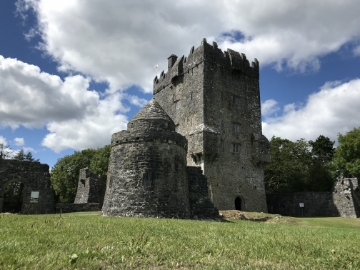
Kylemore Abbey
One of the most impressive and picturesque castles in Galway, Kylemore Abbey and its grounds are among Connemara’s most popular tourist attractions. Situated overlooking Lough Pollaacapull with the backdrop of Druchruah Mountain near Letterfrack in north Connemara, its picture postcard setting never fails to stop visitors in their tracks.
Built by Mitchell Henry as a love token to his wife Margaret after they saw a hunting lodge at the site while travelling through the area in the 1850’s. When she passed away, he had the neo-Gothic Church developed in her memory. The abbey was used by Benedictine nuns after the first world war where they also ran a boarding school for girls until 2010.
The famous Victorian Walled Gardens were created along with the Castle and once featured 21 heated glasshouses and a staff of 40 gardeners. Kylemore Abbey, its magnificent Victorian walled garden and neo-Gothic church in this truly stunning destination in the west of Ireland is a must see during any visit to Connemara, Co. Galway.
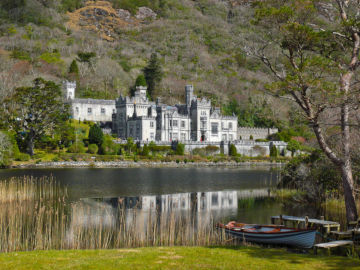
Portumna Castle
This 17th-century partly fortified Renaissance-style house with formal enclosed gardens and courtyards is a grand sight adjacent to Lough Derg on the outskirts of Portumna Town. A defensive stronghold for the De Burgo family, a famous Norman clan, it was abandoned after an accidental fire in 1826 and reconstructed in 1862. Another fire in 1922 burnt it again to the ground, and the last Marquis of Clanricarde sold it to the state in 1948. It is now well-restored to its former grandeur and is a popular attraction for visitors to Portumna.
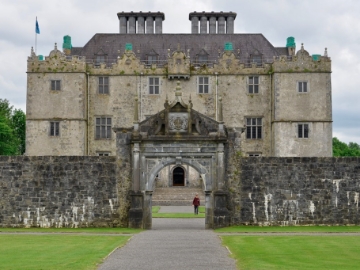
Athenry Castle
Situated overlooking the Clarinbridge River, this famous 13th-century castle was built as a defensive structure by Meiler de Bermingham and still retains parts of its medieval enclosure walls and battlements. History buffs will appreciate its location in the heritage town of Athenry. Besides its unique stone carving with floral imagery, the castle features an interesting entrance – a set of wooden stairs outside the walled building, originally meant to be burned or removed during battles to keep invaders away.
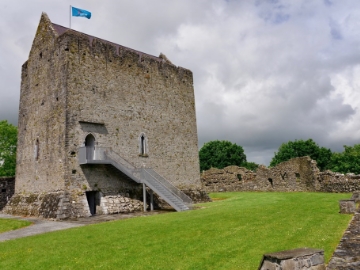
Menlo Castle
Facing Lough Corrib and recently cleared of its thick overgrown vegetation, the ruins of Menlo Castle rest serenely just outside Galway City on the shores opposite the sportsgrounds of Galway University. From the 16th to the early 20th century, it was home to the wealthy Blake family, with the Jacobean mansion added to the original old tower in the late 17th century. In 1910, it fell to a tragic fate when a fire destroyed the building and its contents, taking the life of two maids and Eleanor, the Blakes’ disabled daughter.
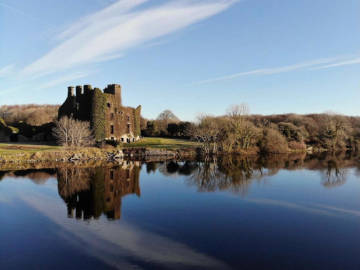
Dunguaire Castle
Ireland’s most photographed castle with its 75-foot tower and defensive wall strikes a dramatic image against southeastern shores of Galway Bay. Built in 1520 near the scenic village of Kinvara for the famous Hynes clan, it then served the Martyn clan until 1924. Oliver St. John Gogarty later bought and restored it as a literary retreat for guests like W.B. Yeats, George Bernard Shaw, and Lady Gregory. Dunguaire Castle was featured in a 1969 Kurt Russell movie, ‘Guns in the Heather’, and ‘North Sea Hijack’ in 1979.
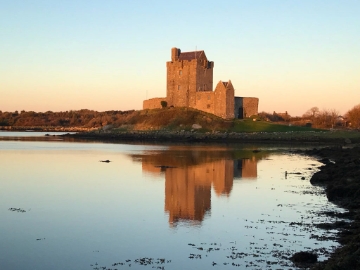
Dunsandle Castle
In the heart of woodland near Athenry lies Dunsandle Castle, an attractive 15th century establishment dominated by the De Burgo family, and shortly after, the Daly clan. A manor house during the 1650s, the castle was uninhabited by 1791 and suffered considerable disrepair until recently being restored. It retains much of its original charm, having unique attractions like the Killing Room, the Ice House, the Great Hall, the Groin Vault, a murder hole, and an anti-clockwise spiral staircase all encapsulated within impressive castle walls.
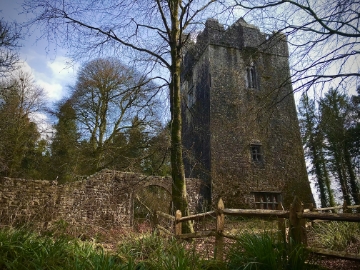
Clifden Castle
Clifden Castle stood proud as an impressive 200-acre Gothic Revival style manor house in its prime, with expansive windows and classic castle décor. Built between 1812 and 1815 for John D’Arcy and his family, it became the subject of neglect by the second half of the 19th century after the area underwent a famine and the D’Arcy family fortunes suffered. About 3 kilometers from Clifden town, the establishment now strikes a rather sad storybook image, its ruins shadowed by the Connemara hills.
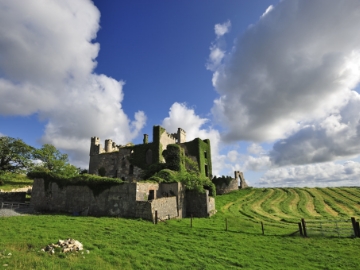
Oranmore Castle
Situated with the scenic backdrop of Galway Bay, Oranmore Castle is a 15th-century structure that once served as a stronghold for a significant Norman family, the Clanricardes. An Cáislean Mór or The Castle of the Well has since seen many inhabitants and undergone multiple cycles of repair and renovation. It was purchased in the 1940’s by Lady Leslie for her daughter, the writer Anita Leslie, whose daughter Leonie continues to reside in the castle. Although a shopping center nearby may somewhat interrupt the scenery from afar, it is the ancient landscape beyond that is certainly a sight to behold. Those intending to explore Oranmore Castle are advised to contact the property directly prior to visiting to ensure access can be provided.
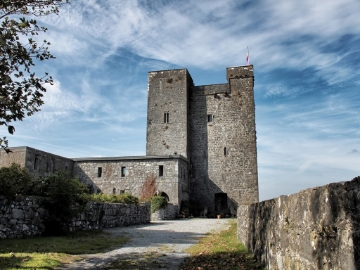
Thoor Ballylee (Yeats Tower)
Thoor Ballylee tower or castle that Yeats bought is a sixteenth century Norman castle built by the family de Burgo, (Burke). It consists of four floors with one room on each, connected by a spiral stone stairway built into the seven-foot thickness of the massive outer wall. Each floor has typical arrowslit windows overlooking the Cloon river which flows past below. The tower has a flat roof reached by the steep flight of steps from the floor below.
There are spectacular views of the surrounding countryside including Coole Parks’ Seven Woods walking trail, from its parapets. There are two cottages attached to the castle, one of which is in ruins. A walled garden is joined to the cottages and a grove of trees across the road. The Cloon river winds through this low-lying, rolling countryside of south county Galway, dropping over a thirty foot waterfall before it flows past Thoor Ballylee and afterwards disappears into an underground limestone passage on its way to enter the Atlantic Ocean.
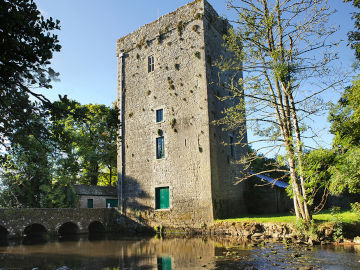
Claregalway Castle
This fully restored 15th-century Anglo-Norman tower house is about 10 kilometers from Galway City, on the banks of the River Clare. With a bloody history that dates back six hundred years, Claregalway Castle was the primary fortress of the Clanricarde De Burgo clan. It opens for tourists for a few months each year, where you can learn about everyday life in the medieval castle, its dark secrets, and the eccentric characters that once occupied it.
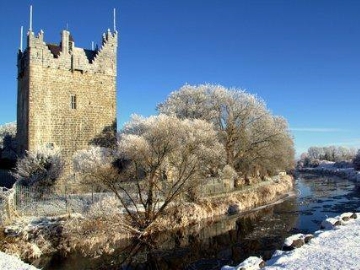
Tyrone House
Tyrone House is situated 3kms from the small village of Kilcolgan in south county Galway on a promontory by the Kilcolgan river, not far from Kilcolgan Castle. Standing three storeys high it enjoys commanding views over Galway Bay and the surrounding countryside. Dating from 1779, it was the home of Christopher St. George and one of the largest homes in Ireland, with the estate covering 53,000 acres at one point. In its heyday the interior of Tyrone House was opulently decorated with the finest furniture. Within the main entrance hall visitors were met by a life sized e statue of Lord St. George and the family’s coat of arms above.
The building is made of blue-cut limestone but the roof and windows are long since destroyed and many features of architectural importance such as corner stones, original fireplaces, balustrades and other valuable features have long since been removed.
In 1920 it was destroyed when during the Irish War of Independence the Irish Republican Army (IRA) burned it down, believing that it would be used by the Black and Tans to treat their soldiers injured in the conflict. In the same period another 200 grand estate houses also suffered a similar fate, including Moore Hall in Co. Mayo which was also designed by the renowned architect John Roberts from Waterford. Today Tyrone House presents as a hollow ivy covered ruin abandoned to the elements but it is still an impressive structure and can be viewed up close from the roadside to its front.
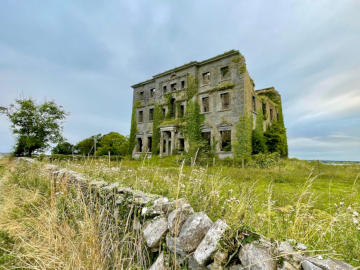
Hen’s Castle/Castlekirk
Above the waters of Lough Corrib, Castlekirk stands as a silent witness to centuries of Irish history and legend. Accessible only by boat, this ancient fortress, known as the Castle of the Hen, holds the title of Ireland’s oldest and arguably best-built castle of its kind.
Perched on a half-acre island, Castlekirk is an early 12th-century tower house, a testament to the architectural prowess of the sons of Ruaidrí na Saide Buide and the assistance they received from William FitzAldelm. The strategic location of the castle, surrounded by rocks sloping abruptly into the water on all sides, made it a formidable stronghold when first erected. The limited accessible points further added to its impregnability, providing a safe haven for its inhabitants.
The castle’s rich history is intertwined with the tales of the renowned Pirate Queen Gráinne Mhaol (Grace O’Malley). In 1546, at the age of 16, Gráinne married Dónal an-Chogaidh O’Flaherty, earning him the nickname “The Cock” due to his aggressive demeanor. In response, Gráinne became known as “The Hen.” The castle itself adopted this poultry-inspired moniker following the murder of Dónal by the Joyces, Gráinne’s rivals. In a bold move, Gráinne reclaimed the castle, forever imprinting it as Hen’s Castle.
The castle retained its military significance until 1654 when it succumbed to Cromwellian forces. However, the 19th century brought a different kind of threat to the historic structure, as vandals desecrated its walls, pilfering hundreds of stones to construct nearby houses.
Today, the interior of Castlekirk’s keep stands as a testament to the passage of time. A mass of stones and weeds now occupies the space where soldiers once stood guard and nobility once reveled. Yet, even in its dilapidated state, Castlekirk remains an impressive sight, evoking a poignant sense of the past.
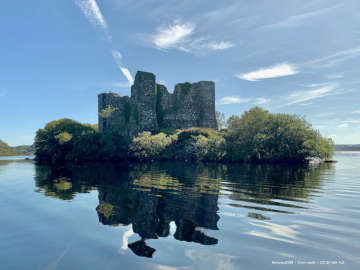
Carraigin Castle
Carraigin Castle is a classic example of the medieval Irish ‘Hall House,’ nestled on the shores of Lough Corrib amongst seven acres of lawns and woodland. This 13th-century fortified manor house has a charming church-like structure. While it crumbled into a roofless ruin at one point, it has now been fully restored for public exploration. Besides sightseeing at the castle and marveling at its history, visitors can spend time boating or fishing at the lake or simply walking or riding around the idyllic location.
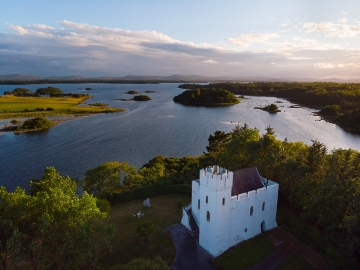
Fiddaun Castle
Fiddaun Castle is located off the Tubber road, 8 kilometers (5 miles) southwest of Gort, in a low-lying plain between two lakes. This tall tower house is most recognized for possessing one of Ireland’s best-preserved bawns. The ancestral home of the O’Shaughnessy family, it was constructed in the 16th century and consists of an oblong, six-story tower with vaults above the first and fifth levels. A unusual Irish design element that resulted from the advent of weapons, which altered the axis of defense from the vertical to the horizontal, is the square bartizans positioned quite low down at third-floor level. When Sir William O’Shaughnessy, the owner of the castle, escaped to France in 1697, the majority of the O’Shaugnessy possessions were forfeited. Although he was just fifteen years old in 1690, he had participated in the Jacobite war as a captain and afterwards pursued a great military career in exile, rising to the rank of Mareschal de Camp in 1734. The O’Shaughnessy family lived at the castle continuously until 1727. (img: Leomyhero – Wikipedia)
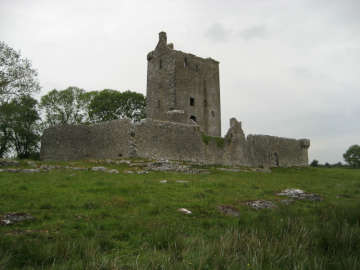
Merlin Castle
Merlin Park Castle is a three-storey medieval tower house built in the 15th or 16th Century for Turlough O’Connor, one of the last High Kings of Ireland. It has been home to many of the most significant tribes of Galway. It was inhabited up to 1812 when the Merlin Park estate was built by Charles Blake.
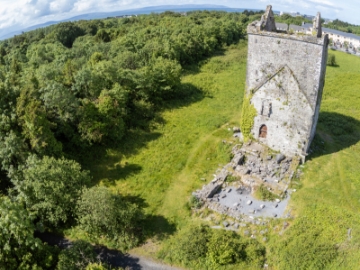
Terryland Castle
Terryland Castle belonged to the Earls of Clanricard, descendants of the De Burgos who came to Galway in the 13th Century. It was attacked twice, in 1652 during the Cromwellian Wars and in 1691 in the Williamite Wars. It was occupied by a joint force of Irish and French troops who defended it against the approaching Williamite Army. After a skirmish during which several people were killed, the Irish and French burnt the castle and retreated behind the walls of Galway. It was never again inhabited. In 1093 six human skeletons were discovered during an archaeological dig near the site when a pedestrian and cycle ramp was installed onto the Dyke Road, adjacent to the castle.
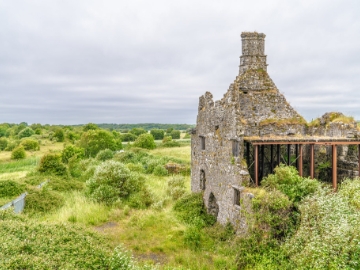
Castles to explore near Galway
Bunratty Castle
The site on which beautiful Bunratty Castle now stands was first settled by Viking traders way back in 970AD. Thereafter its strategic importance in terms of controlling the Shannon basin was reflected by the construction of a series of ever improving forts and castles. The present structure is the last and largest of four castles to be built on the site.
The first of the four was built in 1250 by Robert De Muscegros, a chieftain of Norman origin, and it took the form of a large earthen fort topped off with a timber tower. But De Muscegros fell out of favour, and his lands and title were summarily gifted to Thomas De Clare who set about building the first stone fortification on the site.
The present Bunratty Castle was built by the MacNamara clan in 1425, but it promptly fell into the hands of the powerful O’Brien Clan, then the dominant family in North Munster. The O Brien’s lived well, taking the title “Earls of Thomond”, and decadently feasting on the very best their lands could offer. Indeed, their stock of wild deer was legendary, and was reputed to exceed 3,000 animals. But the arrival of Oliver Cromwell’s forces put an end to this great decadence, and the O’Briens left Bunratty forever.
Visitors can take the Bunratty Castle tour, and get a glimpse of life as it was lived one thousand years ago.
The Bunratty Folk Park within the castle grounds is a living reconstruction of the homes and environment of Ireland of over a century ago. Rural farmhouses, village shops and streets are recreated, furnished and brought to life with costumed residents dressed as they would have appeared at that time. Battles during the 1798 rebellion are re-enacted on site daily during summer months and on weekends throughout the year.
Every evening the Ladies of the Castle, aided and abetted by the Earl’s Butler, welcome guests from the four corners of the globe to dine at The Earl’s banqueting table. The evening’s entertainment is a fitting compliment to a mead reception, a four-course feast, and fine wine.
A new, state of the art gift shop and café are on site to provide tasty refreshments and the change to pick-up a souvenir for relatives or friends back home. All in all, Bunratty Castle provides a delightful journey into the past.
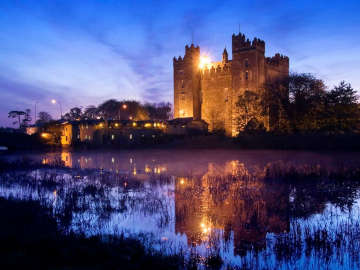
Doonagore Castle
Doonagore Castle is a circular, 14th century tower house with a small walled enclosure, in the outskirts of the small town Doolin in county Clare, Ireland. Also known as the ‘fort of the rounded hills’ and ‘the fort of the goats’, Doonagore sits on a high hill overlooking Doolin. It is used as a navigational point, for boats, which come into Doolin Pier.
The castle was built by Teigue MacTurlough MacCon O’Connor, from stone drawn from the quarry of Tra Leachain some time during the 1300’s, although some sources date the castle to the 15th century. It was granted to Sir Turlough O’Brien of Ennistymon (a neighbouring town of Doolin) in1582. Then during the retreat of the Spanish Armada in 1588, from its failed attempt to invade England, 170 survivors of a Spanish shipwreck were caught by the high sheriff of County Clare, Boetius Mc Clancy and then were hanged at Doonagore Castle and buried in a barrow outside of Doolin.
In the early 1800’s the castle was repaired, but by the middle of that century, it had begun to deteriorate once again in the hands of the Nagle family. A private purchaser who resides there once again restored it in the 1970’s.
Doonagore castle is a magnificent sight on the hill looking out over the Atlantic Ocean, surrounded with nothing but green fields and hills. The setting is quite isolated and lonely but the beauty of the castle and its history is still superb. For those who like to walk and appreciate fresh air and breathtaking views, Doonagore Castle is the place to see.
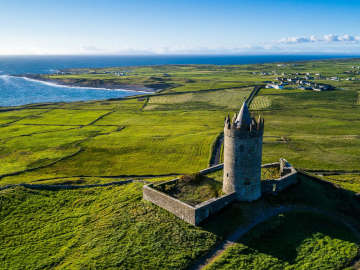
Galway Castles Map
Questions about Galway Castles
What castles are worth visiting in Galway?
What castles are closest to Galway City?
- Lynch’s Castle (Galway City Centre)
- Terryland Castle (1km)
- Menlo Castle (3km)
- Ballindooley Castle (4.2km)
- Merlin Doughiska Castle (5.1km)
- Killeen Castle (7km)
- Cloonacauneen Castle (7.6km)
- Ballybrit Castle (7.7km)
- Oranmore Castle (9.7km)
- Renville Castle (16km)
What castles near Galway can you stay in overnight?
- Abbeyglen Castle Hotel
- Ashford Castle
- Ballynahinch Castle Hotel
- Carraigin Castle
- Cloghan Castle
- Cloonacauneen Castle
- Glenlo Abbey Hotel
- Gregans Castle
- Lough Cutra Castle
See a full list of Castle Hotels in Galway here.
